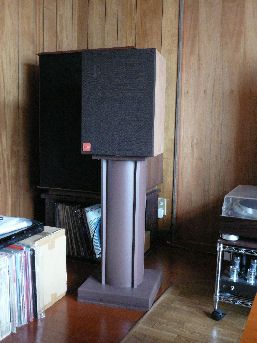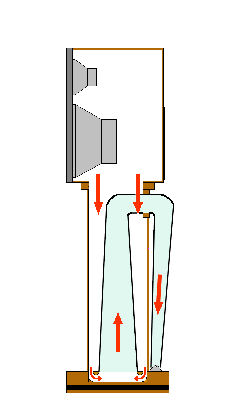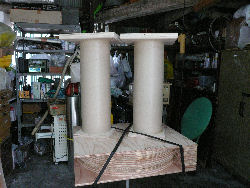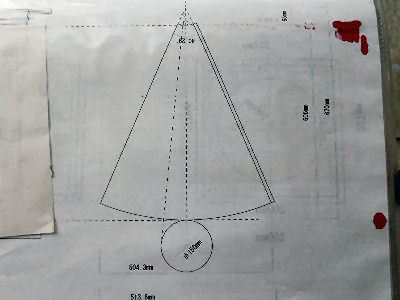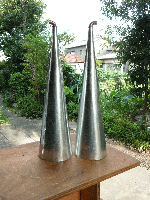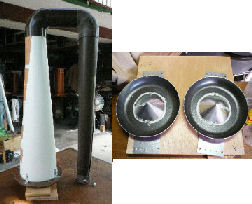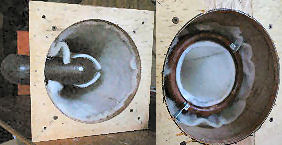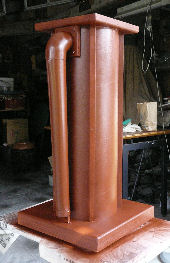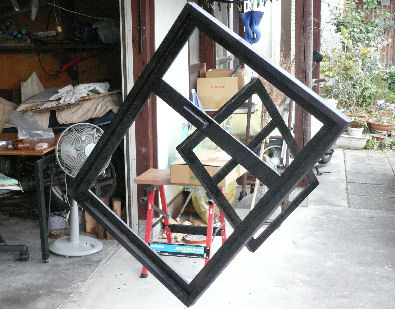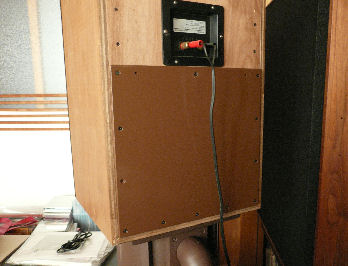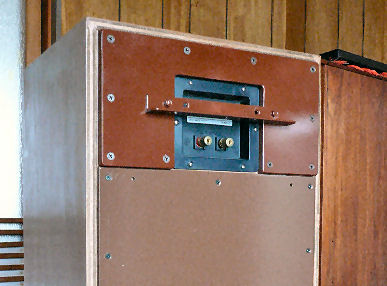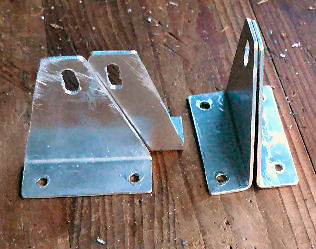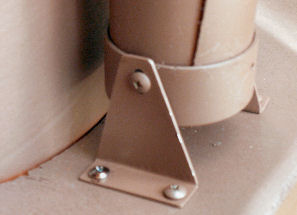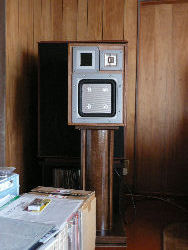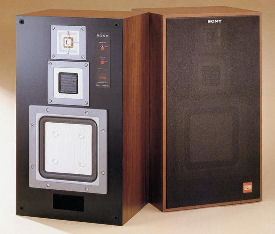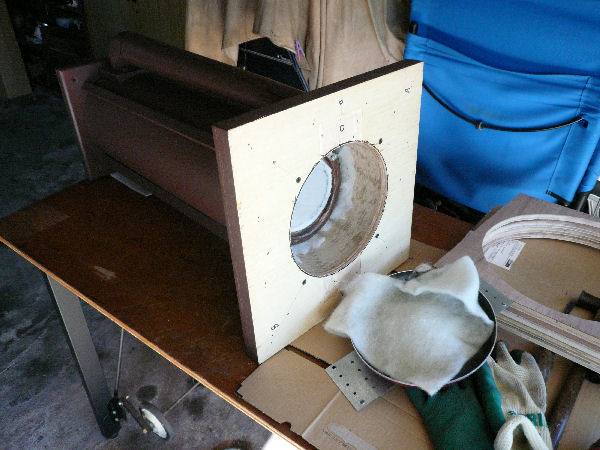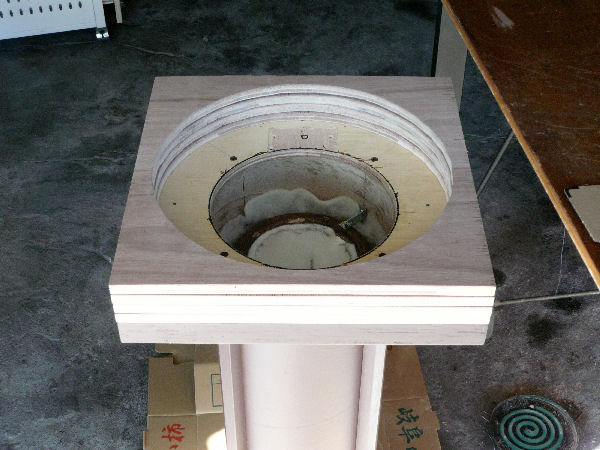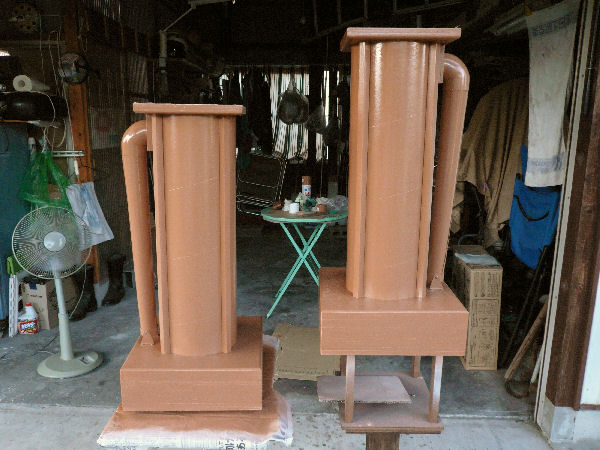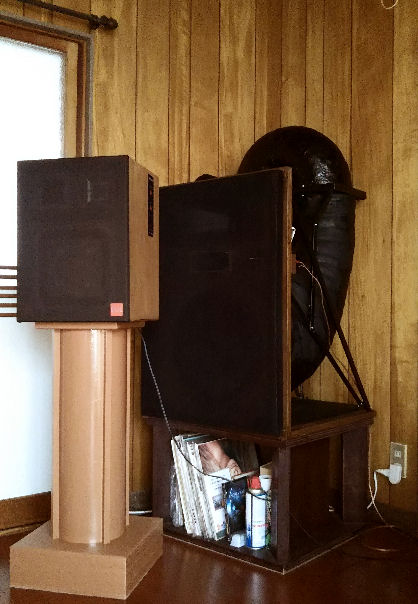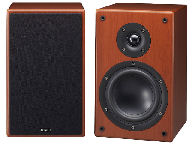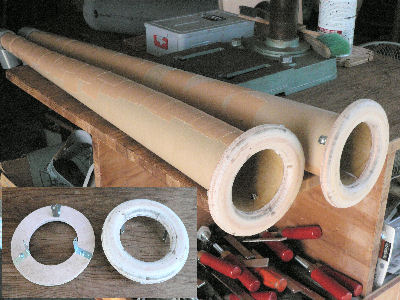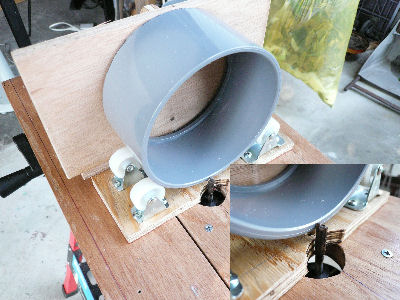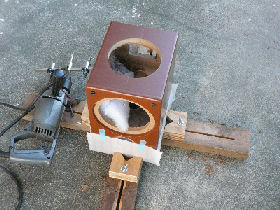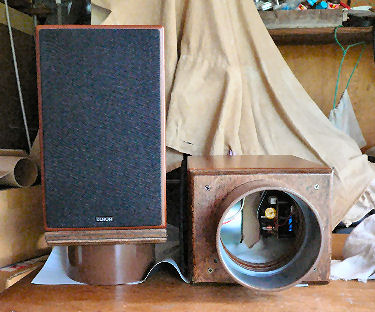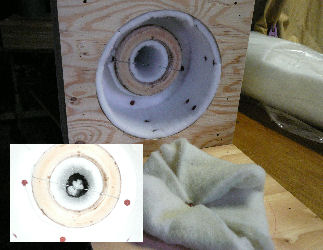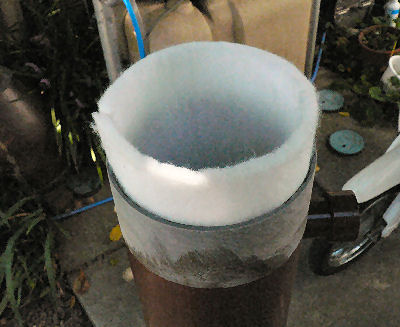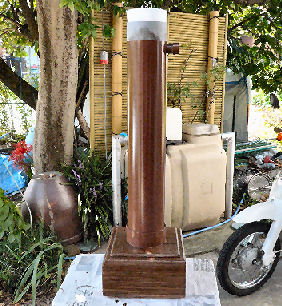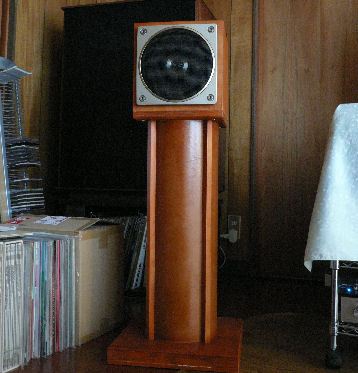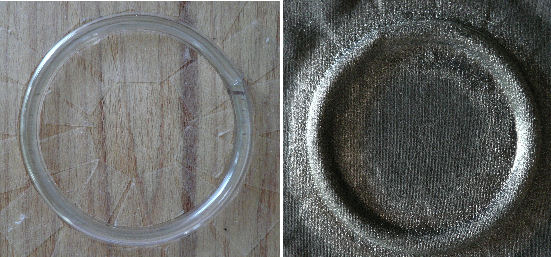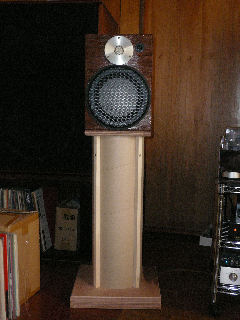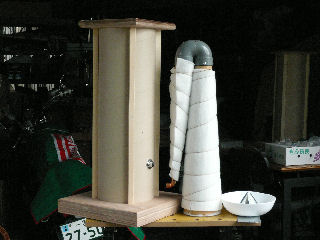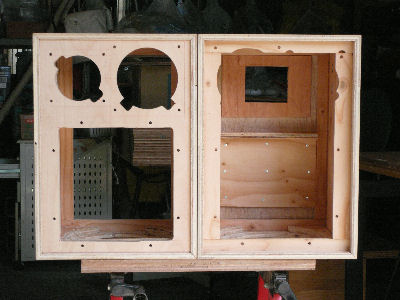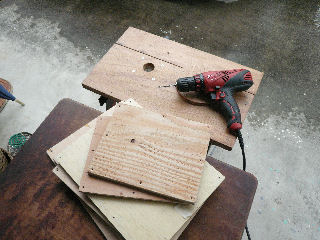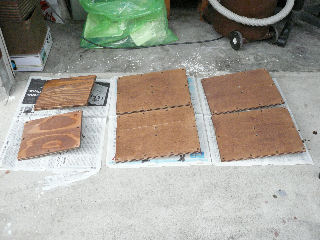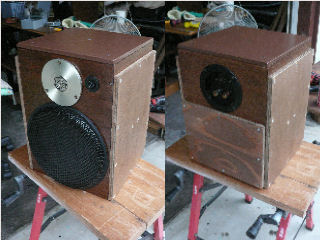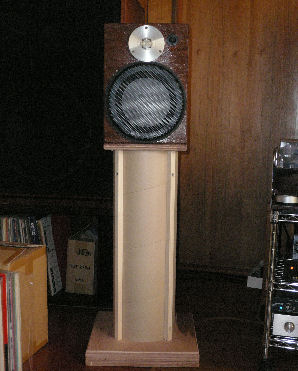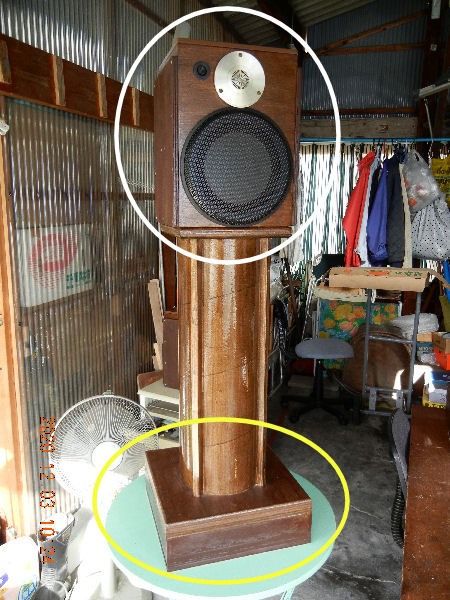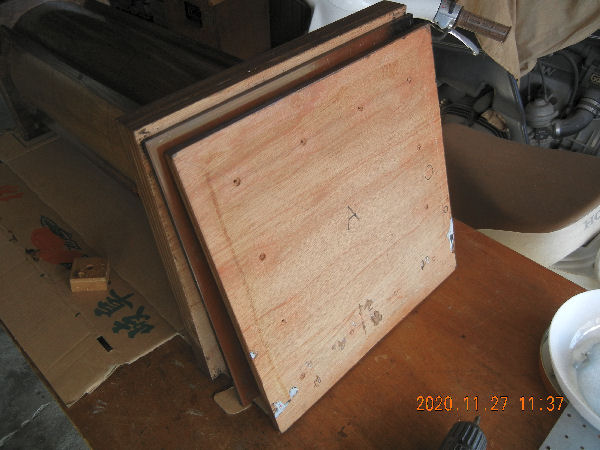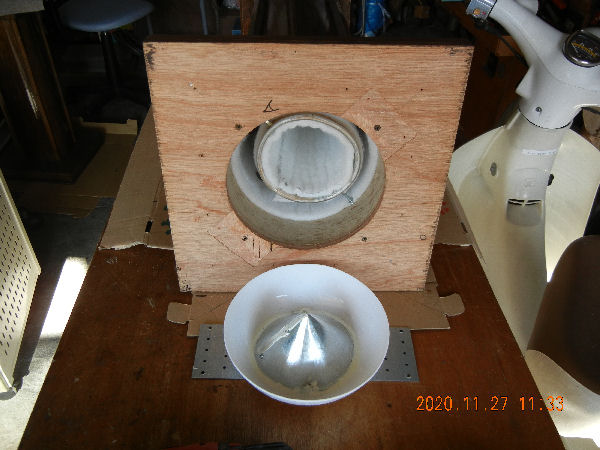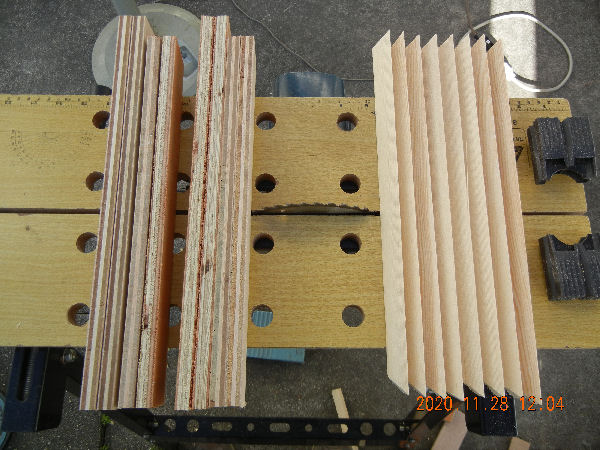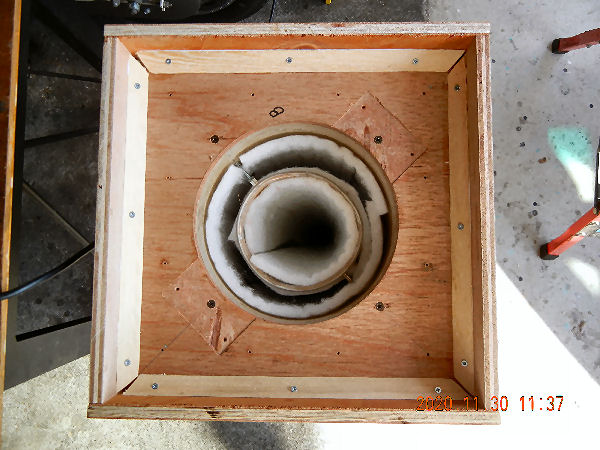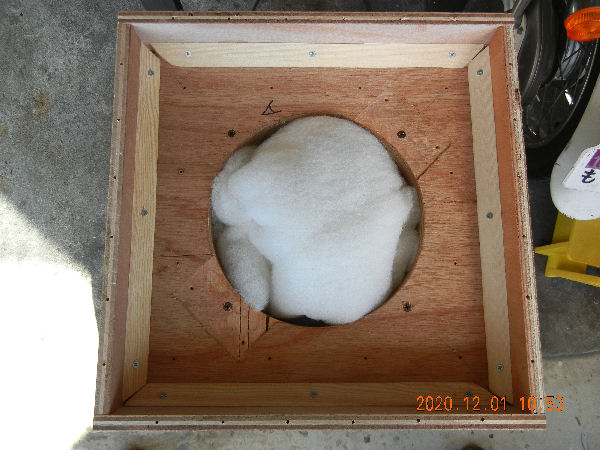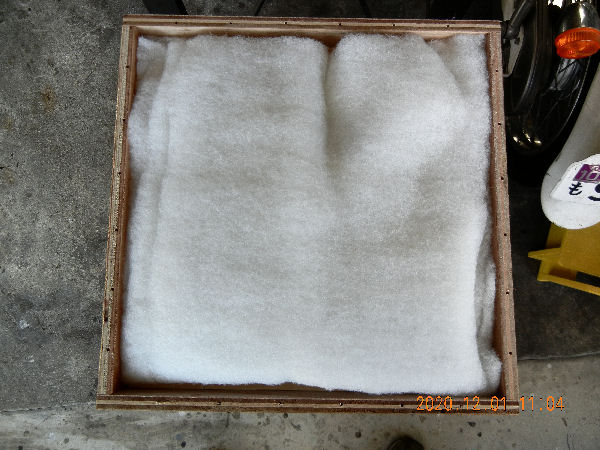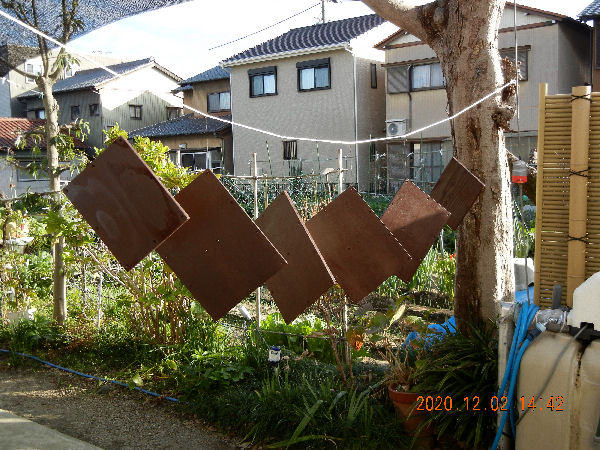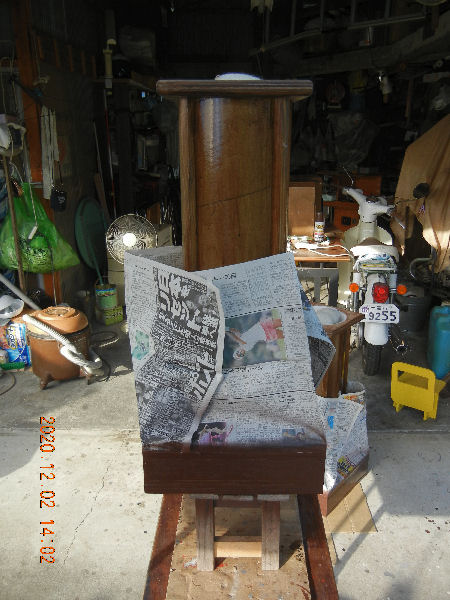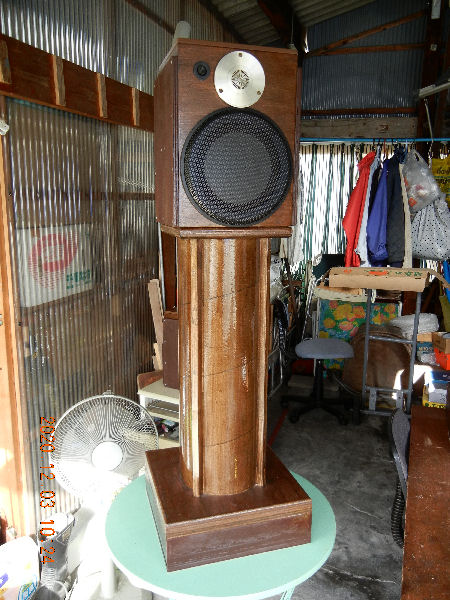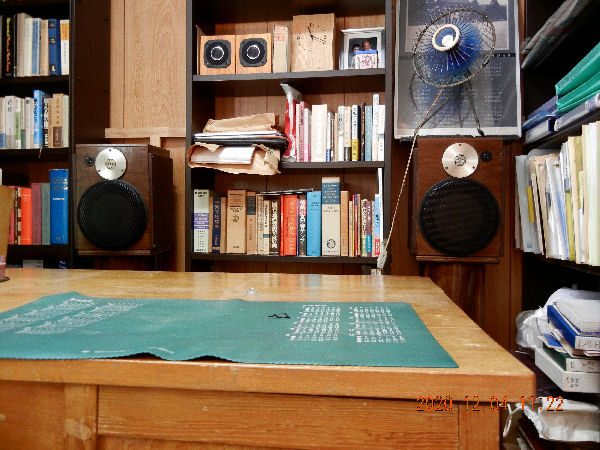Preface Skip Preface
EV speakers in Yamaha Cabinets have long been set in our living room not used but occupying considerable space.Once they were almost engaged to be given to a friend of our sons. However, I changed my mind while he had been too busy to carry them to his place. I decided to build a new set of speaker systems installing the units in those cabinets, perhaps for the last speaker system building in my life.
The name of the new system is nautilus D.I.Y. version. For they have big sound muffling ducts like Nautilus produced by B&W.
The introduction in a pdf is here.
The introduction on YouTube is here.
The truth is I had tried to build a copy of Nautilus by woodwork a few years ago but failed because I injured my dominant arm by using it too hard. Since then I had thought about making ducts with FRP but making the shape of nautilus shell with FRP discouraged me.
-1/32-
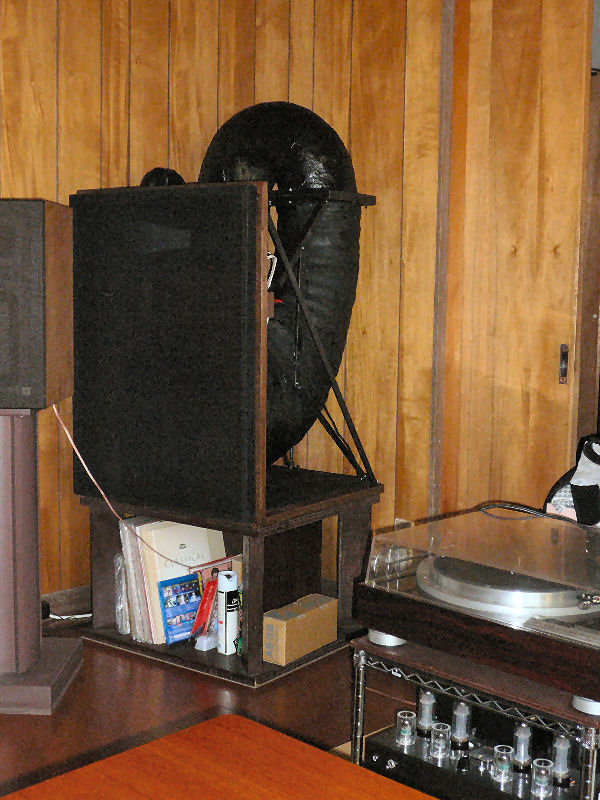
However, the three-dimensional big lanterns of the Nebuta Festival in Aomori gave me a hint of easier way of making FRP ducts.
Thus I resumed building the sound muffling duct installed speaker system as in the photo. It took one month for designing and almost four months for building.
I started using them in July 2018.
-2/32-
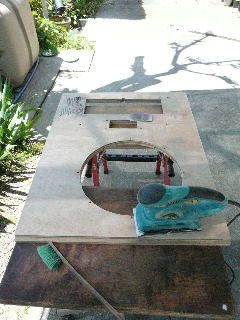
Sanding of a buffle after making it two layered.
I had the plywood cut at the diy shop I bought it. I selected the shop for the board to be cut in exact sizes. However, I was unlucky this time with the person who cut my board. He made four wrong cuttings. I had to brought back two of them to be cut in right sizes. Of other two, I compromised with them and used as they were.
N.B.Nautilus is the product name of B&W.
-3/32-
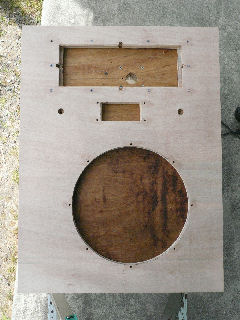
The baffle with needed holes and openings aftrer being sanded down.
For marking holes for fitting screws I placed actual speaker units for marking. However, the attenuators and the tweeters couldn't be fitted. The board was too thick for them and I had to take amending measures.
I had to make the shafts of attenuators longer with adding pieces of same sized metal pipe. Of the tweeters, I couldn't fit them on the outside of the board. So they were fit on the inner side.
-4/32-
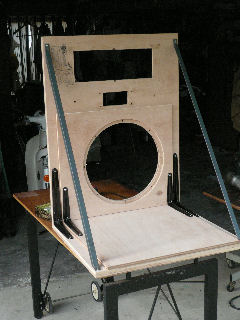
A baffle and a duct rack temporarily joined for checking. The metal stays for shelves are not eternal.
-5/32-
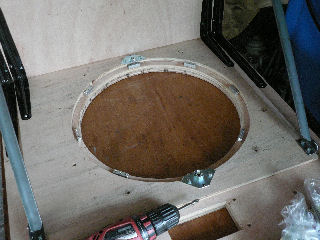
I had to make and install self-supported nuts for fitting woofers before completing ducts as they can't be reached for tightening after assembling the ducts.
I used alminum shaft fot making those nuts, installing a tapped hole in the center and two smaller holes for supporting nails on each piece.
-6/32-
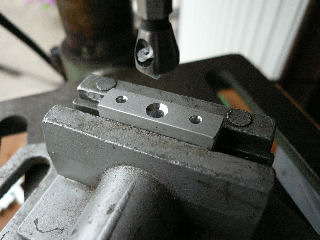
The photo shows how I processed an aluminum piece into a self-supported nut.
-7/32-
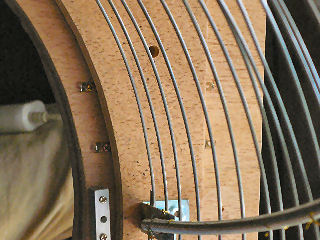
The signal feeding terminals for a woofer and a self-supported nut are showing. The junction of the duct framework onto the rack is not yet treated.
The duct framework is connected later to the baffle board using two nut-welded plates, four L-shaped metal fittings, and stainless net. The last was nailed and bonded to the board.
The board seemed to warp as I worked on it. So, I made all possible measures to strengthen the junction not to let it break when the duct rack is joined tight to the baffle board.
The signal feeders for woofers are made of cupper. They were installed along the 0.5mm-deep cuts on the baffle board made by a trimmer.
-8/32-
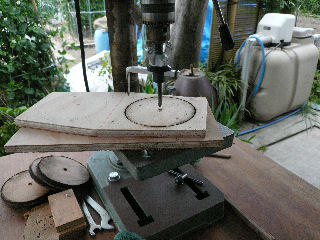
Woodwork:joint boards
-9/32-
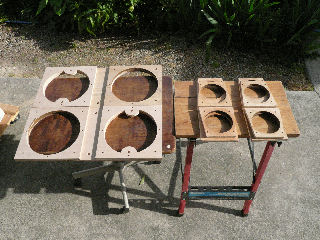
Making a smaller smooth opening on a joint board.
These are the joint boards used between ducts on which are mounted u-shaped flexible aluminium ducts.
You need a fret saw for cutting openings with projections.
-10/32-
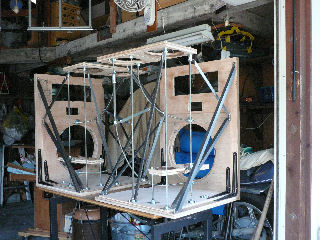
Assembling all frameworks to check rooms for each duct.
It appeared at this stage that there were two points where ducts collide.
-11/32-
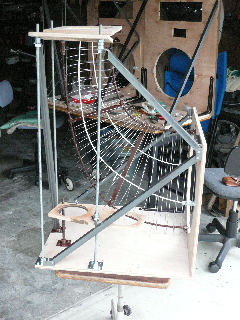
Making the framework of the first duct.
I used #16 stainless wire for the duct framework. Two 10mm-thick bolts and two 6mm-thick bolts I used for stays.
I expected that the framework can be easily made utilizing springy stainless wire but it was utterly contrary. It needed time and patience, killingly.
I added wire to make the basket framework denser after it was once completed to ensure safer FRP installing.
Wire is fastened onto stays at every crossing point adjusting it for the final surface to become smooth. However, the finish turned out to be bumpy on the surface.
The total length of the stainless wire came to 90 meters.
-12/32-
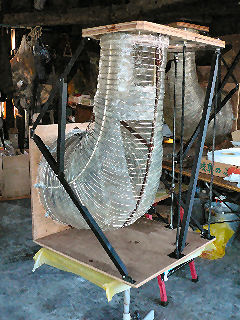
Installing FRP inside the wire framework.
To tell the truth, I wasn't sure if my imaginary way of installing FRP was actually possible. So, I bought only 250g FRP material first for trial. It turned out okay and I ordered the total FRP materials.
I installed one layer of FRP inside the wire framework, two layers outside. The surface layer outside is made of a stretchy glass fiber knit with resin that contaied paraffin.
-13/32-
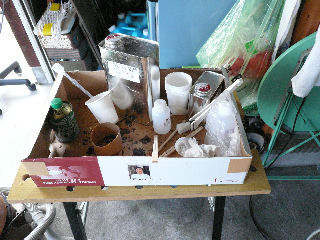
My FRP workdesk
Tools were paper cups, a calibrated syringe, disposable chopsticks, painting brushes and waste cloth. I prepared cleansing liquid but it was useless.
FRP making was the repetition of preparing a cup of resin to be mixed with curing agent, placing a proper sized 10cm-wide glass mat onto the wire framework and applying polyester resin onto the mat to be soaked in.
I continued the work day after day for more than a week. Air temperature was higher and resin hardened quicker even with less curing agent. It was long busy work. Killing again.
On the first day I breathed in too much resin vapour and I felt sick that night. So, from the next day on I used two fans plus I did the work almost out of my workshop.
-14/32-
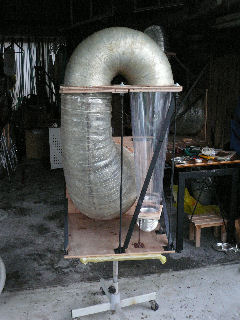
As had been repeated with my past buildings, the components can never be accurately cut as designed.
So, my building is always accompanied by adjusting processes. Here is a second duct being adjusted with its length and angle.
-15/32-
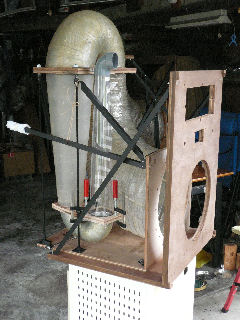
Adjusting a third duct to be fitted.
-16/32-
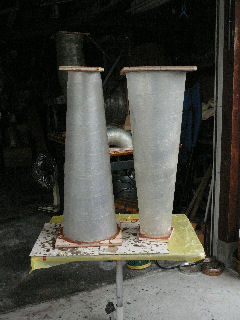
Here are second ducts with their FRP covering finished.
The base cone is made of polyvinyl chloride sheet. They were polished by a wire brush and covered by double layered FRP.
The first layer is glass mat reinforced. The second by stretchy glass fiber knit. The surface was grinded to be painted.
The cone was connected to the board with a bonding agent and nails. I also drove nails for them to serve as anchors of FRP.
-17/32-
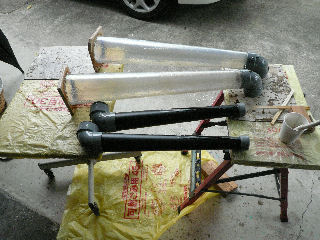
The third and the fourth ducts.
The third duct has only one FRP layer over the polyvinyl chloride cone as I judged the acoustic pressure is very low here.
The fourth duct is made of pvc pipe and elbow。
-18/32-
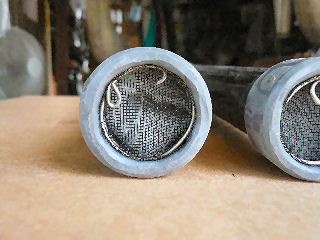
I installed net at the throat in order to stop bugs from entering.
-19/32-
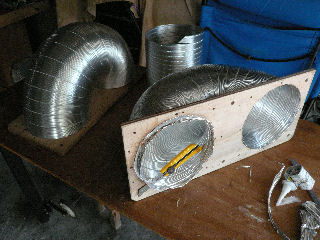
A junction between the first and the second duct. It is made of flexible aluminium duct to be covered with double FRP layers. The diameter of the duct is 20cm.
The junction between the second and the third cones is also made of flexible aluminium duct to be covered with a single FRP layer. The diameter is 10cm.
The diameters of these flexible ducts deviate from those in the original design. There were no actual ducts with diameters as designed in my plan. They were simply selected from among those sold at a diy shop nearby.
Making the first into a u-shaped junction was difficult as its radius was too tight.
These u-shaped junctions were connected to the board with a bonding agent and nails. I also drove nails for them to serve as anchors of FRP.
-20/32-
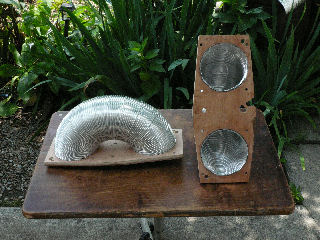
Installing FRP inside the wire framework.
To tell the truth, I wasn't sure if my imaginary way of installing FRP was actually possible. So, I bought only 250g FRP material first for trial. It turned out okay and I ordered the total FRP materials.
I installed one layer of FRP inside the wire framework, two layers outside. The surface layer outside is made of a stretchy glass fiber knit with resin that contaied paraffin.
-32/21-
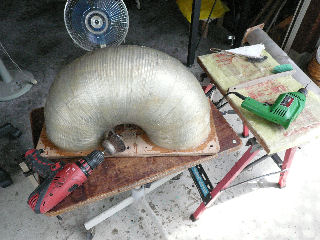
The flexible junctions were polished by a wire brush for painting. I found the polyester is very hard.
Other ducts were also treated likewise for painting.
-32/22-
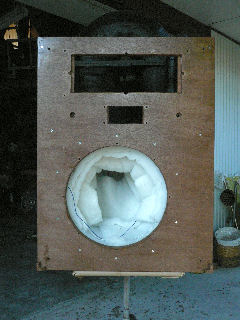
The first duct was lined with sound absorbing material thick inside. I worked overtime that day as I wanted to see how it becomes.
-23/32-
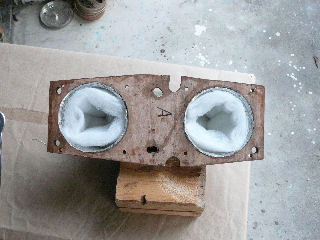
The second u-shaped junction lined with sound absorbing material.
The junction board has an unnecessary hole and a cut for fixing it on the duct rack, for I placed the u-shaped junction on the wrong side and I had to added a new hole and a cut.
Other ducts were also lined likewise with sound absorbing material.
-24/32-
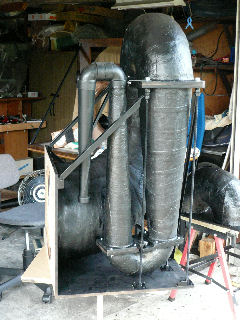
Final assembling
All the duct components were assembled on the duct rack. The black color was picked up as I wanted to finish the work any quicker by painting with only one color.
The duct rack is ready to be coalesced with the baffle board.
The long building work was coming to the end. I fond I was excited that day. I made a few smaller mistakes in my daily life.
-25/32-
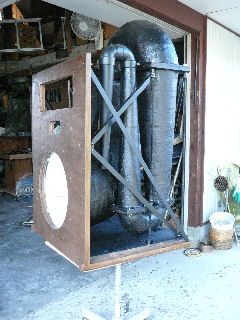
The duct rack coalesced with the baffle.
The remaining work to be done in my workshop was to install a speaker network and attenuators.
However, I had to lengthen the shafts of attenuators before their installation.
On top of it, I found at this stage there was no proper space for an attenuator box to be fitted behind the baffle board. I had to give up fitting one encased in a plastic box. It was only possible to fix one naked. Thus the day passed without actually installing them.
-26/32-

Overcoming such last unexpected troubles I almost finished "nautilus diy version" and placed them in the living room.
Carring them was another problem. The distance from my workshop to the living room was about 20 meters. The path was narrow and there were many potted plants. So the path had to be cleared first.
The system was too heavy for me to carry in my arms. So I had to make a temporary rack to carry them by a two wheeler we luckily had.
Old man I was, I could carry and set them to the room alone at last. Well done!
-27/32-
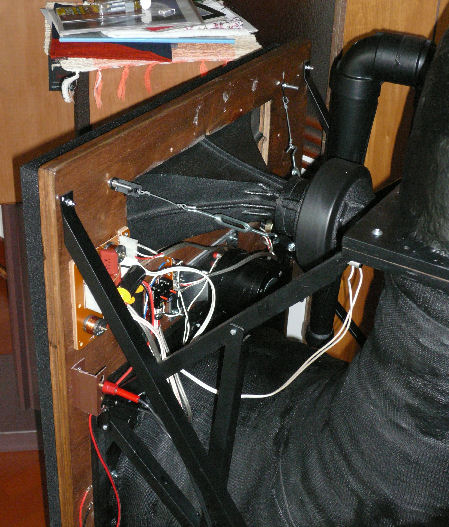
Behind the baffle.
I couldn't encase the network as I mentioned above.
The weather had taken my side while I kept on building them for about four months. Even during the last one month in the rainy season, it rained only one day or two when I gave up building them. Lucky I really was.
-28/32-
Supplement:Network encased.
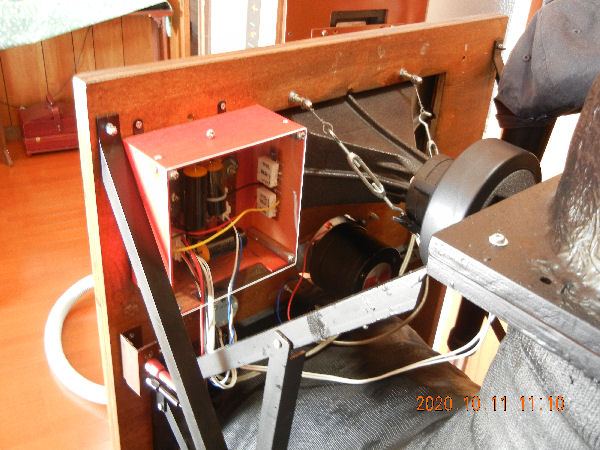
More than three years had passed since the system was completed and I could finally made cases into which I put network devices. Please visit here for details.
―Supplement―
Review
Review
Compared with the sound of "EV speakers and Yamaha cabinets" the sound is lucid.This is what I expected most to this speaker system, which is very reasonable because the sound is not blurred by the sound from the reflex ports.
This characteristics, of which tendency is shared by my buhsp1 system is much more obvious. That is, the sound in the duct is free of cross-mode propagation whaeras with buhsp1 such propagation, theoretically, might be happening because its duct covers all the sound range.(to be continued)
-29/32-
Review
Conclusion: The sound is lucid and delicately expressive. It is so natural that you'd assume the sound is born there without speakers.
-30/32-
Postscript
Postscript
There were very many items to make. The building days were the days of perseverance. The processes looked never progressed.The making the frameworks of Duct1 and giving FRP on them was difficult and time consuming work which I had never experenced before. It required perseverance so much that I felt a foreboding of good performance.
Not all the processes turned out as planed but I could tackle each deviation and the finished makeup was within my original imagination.
-31/32-
Data
● DuctsDuct1: made of stainless wire(#16) + three FRP layers
Duct2: hard polyvinyl chloride sheet + two FRP layers
Duct3: hard polyvinyl chloride sheet + one FRP layer
Duct4: polyvinyl clolide pipe and elbow
● Network: Cross over 800Hz、6000Hz(diverted from Technics SB-7)
● Tweeter:EV T350 3.5kHz~15kHz ±3dB
● Squawker:JBL horn(2730A horn + 2426 driver)800 Hz~20 kHz response
● Woofer:Radian2216 40~3.5kHz voicecoil diameter 10.5cm
-32/32-
End of Nautilus D.I.Y.

